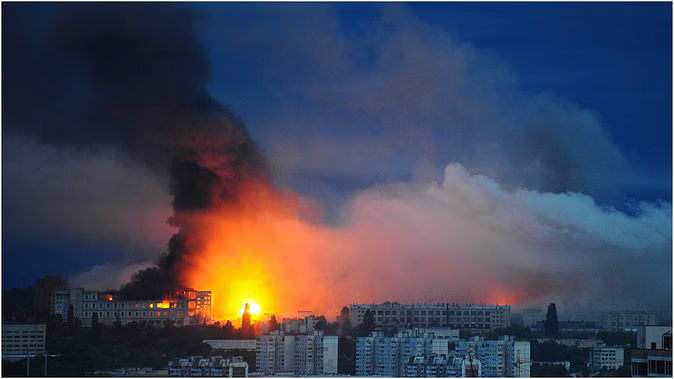Russia-Ukraine Conflict Escalates: Heavy Aerial Bombardments Leave 4 Dead and Many Injured
The Russia-Ukraine war intensified overnight as both countries launched a series of deadly aerial strikes targeting civilian and strategic infrastructure. The overnight assaults resulted in at least four confirmed deaths—two in Ukraine and two in Russia—and left several others injured across multiple regions.
On Friday night, Russia and Ukraine conducted mutual air strikes that extended across various cities and regions. The Ukrainian cities of Dnipro, Sumy, and Kharkiv came under heavy fire from Russian rockets, drones, and guided missiles. According to local Ukrainian officials, the attacks on Dnipro in the south and Sumy in the northeast led to widespread destruction. Dnipro’s regional head, Serhiy Lysak, confirmed the death of two individuals and injuries to five more. A multi-storey residential building and several commercial establishments were hit, with a major shopping complex catching fire during the bombardment.
In Sumy, three people sustained injuries during the air strikes, while the city of Kharkiv experienced one of the most intense bombardments in recent weeks. Ukrainian authorities reported that four guided aerial bombs, two ballistic missiles, and approximately 15 drones were launched toward Kharkiv over a span of three hours. This wave of destruction caused significant damage to residential complexes, commercial outlets, road infrastructure, and communication lines.
Kharkiv’s mayor confirmed that five people were injured in the city, including three emergency rescue personnel. He also stated that the Russian military appeared to have launched a secondary attack specifically targeting the emergency responders as they were attending to the casualties from the initial wave—an increasingly frequent tactic in the conflict.
Ukraine’s Air Force, in its daily situation report, revealed that Russian forces had unleashed a staggering 208 drones and 27 missiles across the country in a single night. Thanks to Ukraine’s advanced air defense systems and electronic warfare capabilities, 183 drones and 17 missiles were successfully intercepted or neutralized. However, 10 missiles and 25 drones managed to reach their targets, striking nine different regions.
Meanwhile, Russia also confirmed suffering casualties and damage from Ukrainian retaliatory strikes. Acting Governor Yuri Slyusar of Russia’s Rostov region—located near the Ukrainian border—reported that two individuals were killed in a Ukrainian drone attack. He added that the drones targeted key infrastructure, including the Signal Radio Plant, known for producing military-grade electronic jamming systems.
In Moscow, Mayor Sergei Sobyanin confirmed that Ukrainian drones had attempted to strike targets within the capital. Although the drones were successfully intercepted, a yet-to-be-identified industrial facility in the southeastern part of the city was impacted. The Russian Ministry of Defense stated that its air defense systems had shot down a total of 54 Ukrainian drones. These included 24 in the Bryansk region, 12 in Rostov, six over Crimea, four above the Sea of Azov, three over the Black Sea, and several more in the Orlov, Tula, and Belgorod regions.
The escalation of drone and missile warfare marks a dangerous shift in the ongoing Russia-Ukraine conflict, with both sides increasingly relying on long-range, high-impact aerial attacks. The use of advanced drone technology and guided munitions reflects a growing trend in modern warfare, and the rising number of civilian casualties and damaged infrastructure paints a grim picture for the immediate future of the region.
As international observers urge de-escalation, the cycle of attack and retaliation shows no sign of slowing down. Civilians on both sides of the border continue to bear the brunt of the conflict, living under the constant threat of the next siren, the next strike, the next tragedy.
